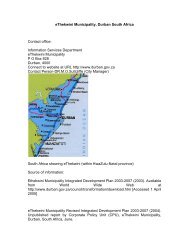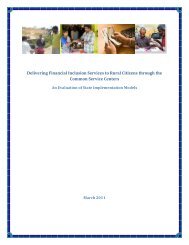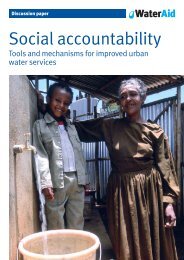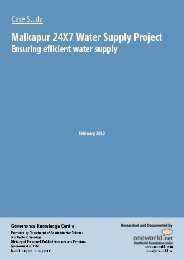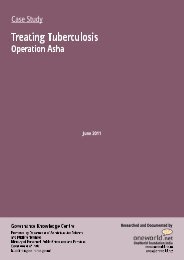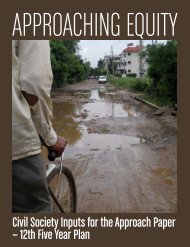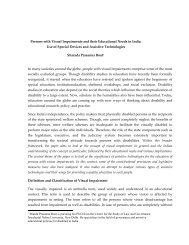EMRI model - Indiagovernance.gov.in
EMRI model - Indiagovernance.gov.in
EMRI model - Indiagovernance.gov.in
You also want an ePaper? Increase the reach of your titles
YUMPU automatically turns print PDFs into web optimized ePapers that Google loves.
Study of Emergency Response Service (<strong>EMRI</strong> Scheme)potentially fatal cases. This refusal to <strong>in</strong>ter-hospital transfers is <strong>in</strong> <strong>EMRI</strong>s view useful toforce the cl<strong>in</strong>ic to take ownership and start stabilisation and care.The Public Sector Ambulance; Given the issues raised by <strong>EMRI</strong> and also the large gapbetween the desired number of ambulances and the numbers we are <strong>in</strong> a position todeploy, there is case for reta<strong>in</strong><strong>in</strong>g the public facility’s ambulance <strong>in</strong> the block level CHCand even <strong>in</strong>troduc<strong>in</strong>g it <strong>in</strong> the sector level PHC - where the IPHS has mandated it.Provided with the same call system and l<strong>in</strong>ked to the <strong>EMRI</strong> call center it could act as aback up <strong>in</strong> cases where the <strong>EMRI</strong> ambulance is too busy, as also be available <strong>in</strong>disasters. It could also help <strong>in</strong> reduc<strong>in</strong>g response and travel time <strong>in</strong> distant dispersedlocations. One current compla<strong>in</strong>t is that the facility ambulance is too often used fortransport<strong>in</strong>g doctors, for VIP roles and for movement of stores. Instead of see<strong>in</strong>g theselegitimate uses as problems, the public sector facility ambulance could be appropriatelydesigned to play a multi-purpose function and act as a backup ERS. But for this it needsto be <strong>in</strong>corporated <strong>in</strong> the communication l<strong>in</strong>ks and <strong>in</strong> the tra<strong>in</strong><strong>in</strong>g and HR developmentprocess.What about care at the hospital? This is one of the weakest l<strong>in</strong>ks of the cha<strong>in</strong>. There aretwo issues here, availability of quality care and the cashless nature of service. Thechoice of hospital to which a patient is transferred assumes great significance. Presentlythe choice is based on proximity of the hospital from the site where the patient is pickedupby the ambulance and with<strong>in</strong> this range the choice as expressed by the patient orattendant. Only those hospitals that are listed/contracted with <strong>EMRI</strong> and are posted ontheir GIS software are considered. But there is also a need to have match<strong>in</strong>g <strong>in</strong>vestment<strong>in</strong> strengthen<strong>in</strong>g the quality of emergency medical services (as different from emergencyresponse services) at the hospital. Public <strong>in</strong>vestment <strong>in</strong> this crucial aspect is howevernot as visible as is the <strong>in</strong>vestment made <strong>in</strong> 108 services, and there is a need to ensure averifiable strengthen<strong>in</strong>g of the emergency care aspect too. We know that both Andhraand Rajasthan are struggl<strong>in</strong>g to achieve their m<strong>in</strong>imum goals of emergency obstetriccare providers. If 20% to 40% are trauma cases, what is the quality of trauma careavailable? Are there enough orthopaedicians available? Are the priorities so skewed thatwe would cont<strong>in</strong>ue to <strong>in</strong>crease <strong>in</strong>vestment <strong>in</strong> transport<strong>in</strong>g patients to hospitals while not<strong>in</strong>creas<strong>in</strong>g <strong>in</strong>vestment <strong>in</strong> the provision of care <strong>in</strong> the hospital? Or do we see this as anopportunity, where the <strong>in</strong>creased pressure on the public health facility due to ERS,forces the state to spend more on care at the health facility level. Could <strong>EMRI</strong> be askedto play a bigger part <strong>in</strong> gear<strong>in</strong>g up emergency management <strong>in</strong> the public health facility,especially <strong>in</strong> some areas like <strong>in</strong> trauma care.Equity Issues <strong>in</strong> Utilisation - Cashless service: One of the key features that ensuresutilization is the cashless nature of service. Irrespective of economic status of the userthere are no user-fees. Though there is a lot of discomfort with this, there are alsopowerful reasons to support it. Firstly, user-fees have been found to be exclusionary,especially for the poor and marg<strong>in</strong>alized. Secondly, targeted systems seldom reach theNational Health Systems Resource Centre (NHSRC)24




